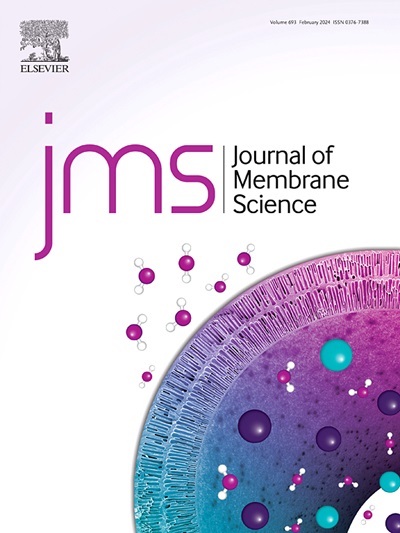Hydrogen recovery using hollow fiber membranes in the ammonia cracking process
IF 8.4
1区 工程技术
Q1 ENGINEERING, CHEMICAL
引用次数: 0
Abstract
This study investigates the separation performance of various hollow fiber membranes (HFMs) for hydrogen (H2) recovery from ammonia (NH3) cracking processes. Oxide-based (γ-Al2O3 and SiO2) and metal-based (Pd and Pd–Ag–Cu) thin films were deposited on α-Al2O3 HFM supports and exposed to H2, N2 and trace of NH3 gas at 450 °C and 0.5–2.0 bar. The separation factor was defined as the ratio of the H2 permeate flow rate to the N2 permeate flow rate (α H2/N2) and to the NH3 permeate flow rate (α H2/NH3). Results show that Pd-based HFMs have better H2 selectivity than oxide-based HFMs. The Pd–Ag–Cu/α-Al2O3 HFM had the highest H2-to-NH3 selectivity with a α H2/NH3 separation factor of 1.4 104 over the tested pressure range. Pressure dependence varied among HFM types, metal-based HFMs showed increased H2 selectivity at higher pressures. These results have big implications for developing advanced membrane-based gas-gas separation processes for H2 purification in proton exchange membrane (PEM) fuel cell (FC) applications. Pd-alloy HFMs, especially Pd–Ag–Cu, are shown to be good for high-selectivity H2 separation from NH3 cracking products.

氨裂化过程中利用中空纤维膜回收氢气
研究了不同中空纤维膜在氨(NH3)裂解过程中回收氢气的分离性能。在α-Al2O3 HFM载体上沉积了氧化物基(γ-Al2O3和SiO2)和金属基(Pd和Pd - ag - cu)薄膜,并在450℃和0.5 ~ 2.0 bar条件下暴露于H2、N2和微量NH3气体中。分离系数定义为H2渗透流速与N2渗透流速(α H2/N2)和NH3渗透流速(α H2/NH3)之比。结果表明,钯基氢基聚合物比氧化物基氢基聚合物具有更好的H2选择性。在测试压力范围内,Pd-Ag-Cu /α- al2o3 HFM具有最高的H2-to-NH3选择性,α H2/NH3分离系数为1.4 104。不同HFM类型的压力依赖性不同,金属基HFM在更高压力下表现出更高的H2选择性。这些结果对于开发用于质子交换膜(PEM)燃料电池(FC)中氢气净化的先进膜气分离工艺具有重要意义。钯合金HFMs,特别是钯银cu,对NH3裂解产物中H2的高选择性分离有较好的效果。
本文章由计算机程序翻译,如有差异,请以英文原文为准。
求助全文
约1分钟内获得全文
求助全文
来源期刊

Journal of Membrane Science
工程技术-高分子科学
CiteScore
17.10
自引率
17.90%
发文量
1031
审稿时长
2.5 months
期刊介绍:
The Journal of Membrane Science is a publication that focuses on membrane systems and is aimed at academic and industrial chemists, chemical engineers, materials scientists, and membranologists. It publishes original research and reviews on various aspects of membrane transport, membrane formation/structure, fouling, module/process design, and processes/applications. The journal primarily focuses on the structure, function, and performance of non-biological membranes but also includes papers that relate to biological membranes. The Journal of Membrane Science publishes Full Text Papers, State-of-the-Art Reviews, Letters to the Editor, and Perspectives.
 求助内容:
求助内容: 应助结果提醒方式:
应助结果提醒方式:


